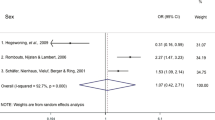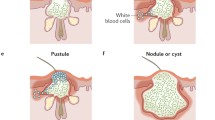Abstract
Purpose
Hormonal imbalance early in life is thought to be associated with breast cancer risk. Severe acne may arise from hormonal imbalance and could serve as an indicator of increased breast cancer risk. We explored whether severe acne was associated with incident breast cancer.
Methods
We used data from the Sister Study, a large (n = 50,884) prospective cohort of women who had a sister diagnosed with breast cancer, but who were free of breast cancer themselves at baseline. Participants completed a structured questionnaire that included demographics, lifestyle factors, and medical history, including any diagnosis of severe acne. Adjusted Cox proportional hazards models were used to estimate hazard ratios (HRs) and 95% confidence intervals (95% CIs) for the association of severe acne and breast cancer (invasive disease or ductal carcinoma in situ).
Results
During an average of 8.4 years of follow-up, 3049 breast cancer cases were diagnosed. Ever being diagnosed with severe acne was associated with a higher risk of breast cancer (HR 1.23; 95% CI 0.98, 1.54), particularly in women who were diagnosed prior to age 18 years (HR 1.40; 95% CI 1.04, 1.90). Results were similar when limited to invasive cancers.
Conclusions
Our study supports a non-significant positive association between severe acne—a potential marker of hormonal imbalance—and breast cancer risk. These findings suggest that severe acne, when considered along with other risk factors, could help to identify women who may be at a higher risk of breast cancer.
Similar content being viewed by others
Change history
21 June 2021
The ESM word file was revised due to track changes.
References
Noone AM, Howlader N, Krapcho M, Miller D, Brest A, Yu M, Ruhl J, Tatalovich Z, Mariotto A, Lewis DR, Chen HS, Feuer EJ, Cronin KA (2018) SEER cancer statistics review, 1975-2015. https://seer.cancer.gov/csr/1975_2015/. Accessed 6 Jan 2018
Colditz GA, Bohlke K, Berkey CS (2014) Breast cancer risk accumulation starts early: prevention must also. Breast Cancer Res Treat 145(3):567–579
Berkey CS, Frazier AL, Gardner JD, Colditz GA (1999) Adolescence and breast carcinoma risk. Cancer 85(11):2400–2409
Robinson WR, Tse CK, Olshan AF, Troester MA (2014) Body size across the life course and risk of premenopausal and postmenopausal breast cancer in Black women, the Carolina Breast Cancer Study, 1993–2001. Cancer Causes Control 25(9):1101–1117
Niehoff NM, White AJ, Sandler DP (2017) Childhood and teenage physical activity and breast cancer risk. Breast Cancer Res Treat 164(3):697–705. https://doi.org/10.1007/s10549-017-4276-7
White AJ, D’Aloisio AA, Nichols HB, DeRoo LA, Sandler DP (2017) Breast cancer and exposure to tobacco smoke during potential windows of susceptibility. Cancer Causes Control 28(7):667–675. https://doi.org/10.1007/s10552-017-0903-1
Barber LE, Bertrand KA, Rosenberg L, Battaglia TA, Palmer JR (2018) Pre- and perinatal factors and incidence of breast cancer in the Black Women’s Health Study. Cancer Causes Control 1:1–12. https://doi.org/10.1007/s10552-018-1103-3
Andersen ZJ, Baker JL, Bihrmann K, Vejborg I, Sørensen TI, Lynge E (2014) Birth weight, childhood body mass index, and height in relation to mammographic density and breast cancer: a register-based cohort study. Breast Cancer Res 16(1):R4
Sandvei MS, Lagiou P, Romundstad PR, Trichopoulos D, Vatten LJ (2015) Size at birth and risk of breast cancer: update from a prospective population-based study. Eur J Epidemiol 30(6):485–492
Neilson HK, Friedenreich CM, Brockton NT, Millikan RC (2009) Physical activity and postmenopausal breast cancer: proposed biologic mechanisms and areas for future research. Cancer Epidemiol Prev Biomark 18(1):11–27
Hankinson SE, Eliassen AH (2007) Endogenous estrogen, testosterone, and progesterone levels in relation to breast cancer risk. J Steroid Biochem Mol Biol 106(1–5):24–30. https://doi.org/10.1016/j.jsbmb.2007.05.012
Ryan R, Tawfik O, Jensen RA, Anant S (2017) Chapter two—current approaches to diagnosis and treatment of ductal carcinoma in situ and future directions. In: Lakshmanaswamy R (ed) Progress in molecular biology and translational science, vol 151. Academic Press, London, pp 33–80
Brown SB, Hankinson SE (2015) Endogenous estrogens and the risk of breast, endometrial, and ovarian cancers. Steroids 99:8–10. https://doi.org/10.1016/j.steroids.2014.12.013
Endogenous Hormones and Breast Cancer Collaborative Group (2002) Endogenous sex hormones and breast cancer in postmenopausal women: reanalysis of nine prospective studies. JNCI J Natl Cancer Inst 94(8):606–616. https://doi.org/10.1093/jnci/94.8.606
Rinaldi S, Key TJ, Peeters PH, Lahmann PH, Lukanova A, Dossus L, Biessy C, Vineis P, Sacerdote C, Berrino F (2006) Anthropometric measures, endogenous sex steroids and breast cancer risk in postmenopausal women: a study within the EPIC cohort. Int J Cancer 118(11):2832–2839
Doyle SL, Donohoe CL, Lysaght J, Reynolds JV (2012) Visceral obesity, metabolic syndrome, insulin resistance and cancer. Proc Nutr Soc 71(1):181–189
Baron JA, Weiderpass E, Newcomb PA, Stampfer M, Titus-Ernstoff L, Egan KM, Greenberg ER (2001) Metabolic disorders and breast cancer risk (United States). Cancer Causes Control 12(10):875–880
Lolis MS, Bowe WP, Shalita AR (2009) Acne and systemic disease. Med Clin N Am 93(6):1161–1181. https://doi.org/10.1016/j.mcna.2009.08.008
James WD (2005) Clinical practice. Acne. N Engl J Med 352(14):1463–1472. https://doi.org/10.1056/NEJMcp033487
Zaenglein AL (2018) Acne vulgaris. N Engl J Med 379(14):1343–1352. https://doi.org/10.1056/NEJMcp1702493
Gollnick HP, Zouboulis CC (2014) Not all acne is acne vulgaris. Dtsch Ärztebl Int 111(17):301–312. https://doi.org/10.3238/arztebl.2014.0301
Zouboulis C, Eady A, Philpott M, Goldsmith L, Orfanos C, Cunliffe W, Rosenfield R (2005) What is the pathogenesis of acne? Exp Dermatol 14(2):143
Zhang M, Qureshi AA, Fortner RT, Hankinson SE, Wei Q, Wang LE, Eliassen AH, Willett WC, Hunter DJ, Han J (2015) Teenage acne and cancer risk in US women: a prospective cohort study. Cancer 121(10):1681–1687. https://doi.org/10.1002/cncr.29216
Sandler DP, Hodgson ME, Deming-Halverson SL, Juras PS, D’Aloisio AA, Suarez LM, Kleeberger CA, Shore DL, DeRoo LA, Taylor JA (2017) The sister study cohort: baseline methods and participant characteristics. Environ Health Perspect 125(12):127003
White AJ, Nichols HB, Bradshaw PT, Sandler DP (2015) Overall and central adiposity and breast cancer risk in the sister study. Cancer 121(20):3700–3708. https://doi.org/10.1002/cncr.29552
D’Aloisio AA, Nichols HB, Hodgson ME, Deming-Halverson SL, Sandler DP (2017) Validity of self-reported breast cancer characteristics in a nationwide cohort of women with a family history of breast cancer. BMC Cancer 17(1):692. https://doi.org/10.1186/s12885-017-3686-6
Wang J, Yang DL, Chen ZZ, Gou BF (2016) Associations of body mass index with cancer incidence among populations, genders, and menopausal status: a systematic review and meta-analysis. Cancer Epidemiol 42:1–8. https://doi.org/10.1016/j.canep.2016.02.010
Weinberg CR, Shore DL, Umbach DM, Sandler DP (2007) Using risk-based sampling to enrich cohorts for endpoints, genes, and exposures. Am J Epidemiol 166(4):447–455
Boodman SG (2006) Too hard to take. The Washington post. http://www.washingtonpost.com/wp-dyn/content/article/2006/09/03/AR2006090300590.html?noredirect=on. Accessed 13 July 2018
Tan J, Boyal S, Desai K, Knezevic S (2016) Oral isotretinoin: new developments relevant to clinical practice. Dermatol Clin 34(2):175–184. https://doi.org/10.1016/j.det.2015.11.002
Cancer CGoHFiB (2001) Familial breast cancer: collaborative reanalysis of individual data from 52 epidemiological studies including 58 209 women with breast cancer and 101 986 women without the disease. Lancet 358(9291):1389–1399
Pharoah PD, Day NE, Duffy S, Easton DF, Ponder BA (1997) Family history and the risk of breast cancer: a systematic review and meta-analysis. Int J Cancer 71(5):800–809
Acknowledgements
The authors would like to thank Nicole Niehoff and Ann von Holle for their review of a version of this manuscript.
Funding
This work was supported by the Intramural Research Program of the National Institutes of Health, National Institute of Environmental Health Sciences (project Z01-ES044005 to DPS).
Author information
Authors and Affiliations
Corresponding author
Ethics declarations
Conflict of interest
The authors declare that they have no conflicts of interest.
Additional information
Publisher's Note
Springer Nature remains neutral with regard to jurisdictional claims in published maps and institutional affiliations.
The ESM word file was revised without track changes.
Electronic supplementary material
Below is the link to the electronic supplementary material.
Rights and permissions
About this article
Cite this article
Murphy, J.D., Sandler, D., White, A.J. et al. Severe acne and risk of breast cancer. Breast Cancer Res Treat 177, 487–495 (2019). https://doi.org/10.1007/s10549-019-05302-z
Received:
Accepted:
Published:
Issue Date:
DOI: https://doi.org/10.1007/s10549-019-05302-z




